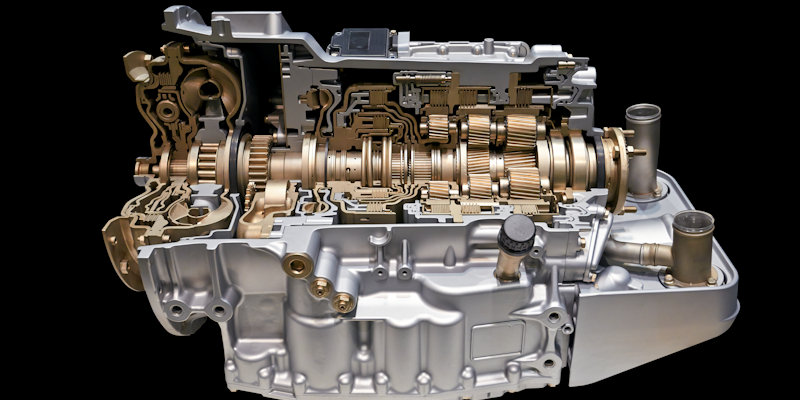
Crawford’s Auto Repair offers transmission service, including a transmission flush, transmission repair and clutch repair to vehicle owners from Chandler, Gilbert and other nearby areas.
Schedule An AppointmentDoes your vehicle delay in shifting gears, grind while shifting or have other gear shifting issues? Are you due for transmission service according your vehicle manufacturer's recommendation? Then bring your vehicle to the shop today for clutch and transmission services. Call 480-201-0740 to schedule an appointment.
What is a Transmission? Why is it important?
The internal combustion engine uses a series of controlled micro explosions to drive pistons up and down in their cylinders. Because of the shape of the parts and control of the firing order from the electrical system and the fuel injection system, the pistons alternate–as one piston goes up the adjacent piston goes down. The pistons are attached in an alternating pattern to a crankshaft, so as they alternate going up and down they are turning the crankshaft in continuous rotational motion. This kinetic energy is then transferred to the wheels through a series of “gear box” parts, shafts and axles, all of which is called the drivetrain. The first of these parts is a “gear box” part called the transmission. When considering the engine and drivetrain together, it’s called the power train.
The shape and position of the transmission will depended on the arrangement of the remainder of the drivetrain. In a rear-wheel drive vehicle the transmission will be cone-shaped with the apex pointing towards the drive shaft and rear differential (or transfer case in an All-Wheel Drive vehicle). In a front wheel drive vehicle the transmission will be combined with a differential and called a transaxle.
The transmission uses mechanical advantage to either increase or decrease the kinetic energy that is received from the engine through the crankshaft. It may help to comprehend how this is done by visualizing a multi-speed bicycle. A multi-speed bicycle will have multiple cogs at the pedals and multiple cogs at the center of the rear wheel. A chain connects a front cog with a rear cog and it moves between cogs when the rider shifts gears. The rider will use high gears to go faster on a level riding plane and lower gears to go uphill. It is the change in mechanical ratios that allows the rider to pedal uphill.
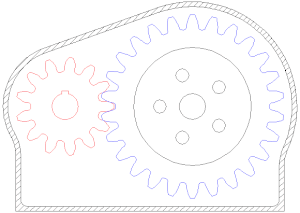
Single stage gear reduction CC BY-SA 3.0 Simiprof
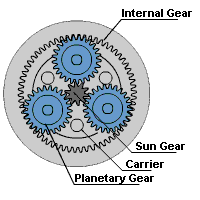
Animation of planetary gears used in automatic transmissions. Image from apexdyna.nl. Used for educational purposes, Fair Use applies.
The gear ratios in a transmission allow for different outputs in an automobile, similar to the bicycle except much more sophisticated. A transmission is essentially a box of gears and the gears get changed appropriately according to the driving conditions. In a manual transmission vehicle the driver is responsible for choosing the correct gear for the speed and incline. The driver does this with a clutch pedal and manual shifter. In an automatic transmission vehicle there is a system of sensors, computers and hydraulics which controls the gears according to speed. The system senses both the change in accelerator depression and incline of the vehicle. Some of the gears within an automatic transmission are called “planetary gears” because they are arranged around a central gear like planets around the sun (or sun gear).
Other major parts of an automatic transmission include a torque converter and transmission solenoid (not to be confused with the Starter Solenoid). The torque converter converts rotational energy from the engine crankshaft so it can be used in the transmission. It resides immediately between the engine and transmission gear box. This can get confusing because some may think of the torque converter as a gearbox itself and there is even a clutch within it. Although when most people speak of “the clutch” they are talking about a manual transmission described in more detail below. The transmission solenoid controls the flow of transmission fluid throughout the transmission.
What Is A Clutch?
As stated above, a clutch is a part that allows shifting between the gears, usually referred to in a manual transmission. A manual transmission is also known as Standard Transmission. Manual transmission vehicles are not as common as they used to be, but they are still around, which means clutch services are still needed. Older generations might like to call manual transmissions “millennial anti-theft devices”.
This series of graphics shows how a clutch allows the driver to shift between different gears of a manual transmission (the transmission gears are always rotating; it’s just a matter of which gears are engaged)
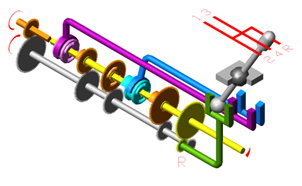
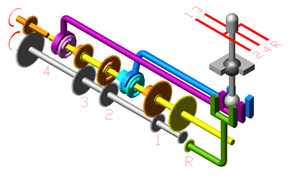
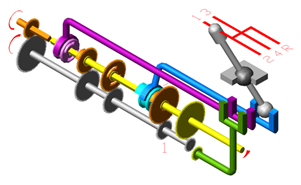

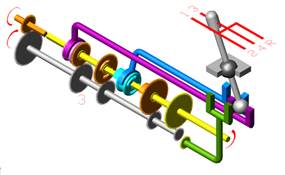
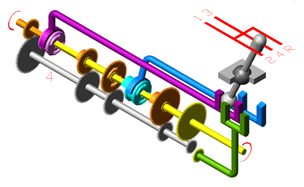
Is the clutch the pedal or the lever?
Sometimes people refer to the clutch pedal as “the clutch” when teaching how to drive manual or when describing how they were driving when they need a repair. In those cases you could refer to the pedal as the clutch and the lever as the shifter. However, the clutch is actually a disc-shaped assembly of parts that allows shifting between the gears which are attached to the crankshaft and the gears which are attached to the drive shaft; the pedal is an accessory to it and the lever is an accessory to the shifting assembly. Yet clutch services would include repairs of the clutch itself as well as repairs to the gears on the crankshaft and the drive shaft or repairs to the shifting assembly, all of which together is the manual transmission. Learn Engineering has a much more detailed video that describes the clutch on YouTube.
This page is dedicated to the importance of the transmission, transmission repairs, and transmission services. It also includes clutch services for manual transmission vehicles. For more details on the rest of the drivetrain see Drivetrain & Differential Services and 4WD & AWD Services.
Clutch & Transmission Maintenance
During standard maintenance checks with every oil change (generally every 5,000 miles) and at every landmark mileage check (30,000, 90,000 and 150,000 miles) the vehicle is test driven and the transmission is inspected visually along with the rest of the drivetrain where ever possible without disassembly.
During the test drive, the technician will note any dashboard indicators that are related to the transmission, as well as any signs while driving related to gear shifting and acceleration. The transmission is the deepest part of the vehicle which makes any inspection and repairs challenging, perhaps comparable only with repairs within the dash. Depending on the drivetrain arrangement, some of the visual inspection might be under the hood from above the transmission, or underneath with the vehicle raised on hydraulic lifts.
If the vehicle has a dipstick for the transmission fluid or an accessible port, then the transmission fluid is checked with every maintenance check. If the fluid is ever found to be low or dirty then further investigation is needed and possibly repairs. Learn more about vehicle fluids maintenance. Depending on your manufacturer’s recommendation, your vehicle may need a transmission fluid flush at certain mileage, better-known as a transmission fluid service. This is described in more detail below.
For some vehicles the clutch pedal can be adjusted as needed with every maintenance check, and depending on vehicle manufacturer specifications, the clutch fluid could be changed changed every 30,000 miles. This could be called a clutch fluid service, clutch servicing or the less desired clutch fluid flush. The owner’s manual is referenced for the exact maintenance schedule.
DIY Maintenance Tips For The Driver:
- Do not “ride” the clutch if you have a manual transmission. Take your foot off the clutch pedal unless you’re shifting.
- If you tow a boat or trailer consider getting a transmission cooler.
Transmission Flush (i.e. Transmission Service or Transmission Fluid Service)
Depending on the specifications from your vehicle’s manufacturer, your vehicle could need a transmission fluid flush about every 100,000 miles. In older vehicles the intervals will be shorter. The vehicle owner’s manual is consulted for the exact maintenance schedule.
The word “flush” is kind of a misnomer that we tend to avoid using in general and for the transmission specifically. We prefer to call this a “transmission fluid service” for more than one reason. One reason is that a “flush” could imply that we run water through the transmission like we do for a cooling system flush, and we don’t! Although a degreaser fluid could be used to clean some of the parts which could be considered a “flush”. Another reason is that the service involves more than just removing the old fluid and installing new fluid. It includes disassembly, installation of a new filter, possible installation of a new gasket, reassembly, and installation of new fluid.
The following is a step by step detail of a transmission fluid service. The steps could vary depending on make and model. Some makes and models are more complicated than others.
- Vehicle is raised on a hydraulic lift
- Drain pan or transmission pan is removed and transmission fluid drained
- Transmission filter is removed
- New transmission filter is installed
- Transmission pan magnet is cleaned
- Transmission pan is cleaned with degreaser
- Replace pan gasket if needed or clean pan gasket if reusing it
- Clean gasket seal surface on the open transmission
- Reinstall transmission pan following any torque recommendations from manufacturer if any.
- All residual transmission fluid from splashing or draining is cleaned off the bottom of the vehicle.
- Vehicle is lowered
- New transmission fluid is installed, ensuring that it is the correct fluid for the vehicle. Fluid is installed cautiously to above the cold engine level (if it’s overfilled the only way to drain it is to remove the pan again.
- Vehicle is driven a couple miles so the engine is hot. Confirm that the fluid is not above the hot engine level.
- Raise vehicle again and confirm there are no leaks
As you can see it’s more than just opening a plug and refilling it. So it’s more than a “flush”, its a “service”.
Warning Lights Related to Transmission
The most common warning light which could indicate transmission problems is the Check Engine Light, however the Check Engine Light is not specific to the transmission and could indicate other problems while the transmission is fine. Your particular make and model may have a different symbol than the one shown. See variations of the Check Engine Light on our Dashboard Light Guide. See also Free Check Engine Light Code Scan.
If your vehicle has it, the transmission temperature or transmission oil temperature warning light indicates that the transmission is too hot. This has the same severity as the engine temperature light and if your vehicle has it, you should memorize it so that you know what to do if it comes on. Pull over as safely and as quickly as possible and turn off the engine to allow it to cool. Continuing to drive while it’s hot will severely damage the transmission up to and including the need for replacement. You’ll want to have the vehicle towed to the shop to avoid damage.
These are additional transmission service lights. They could indicate that service is due or that there is an issue that needs inspection and repair. Red is probably more urgent than orange or yellow, although that is not a universal rule of thumb.
It is most likely that these indicator lights will be present on vehicles that require a lot of engine power, such as 4-wheel drive (4WD) and vehicles made for towing. There may be other indicator lights that are specific for 4WD and AWD vehicles. A manual transmission might have other indicators that indicate when it’s best to change gears or brake.
We only include indicator lights that suggest the need for servicing here. Consult your owner’s manual for additional indicator lights.
Signs Of A Failing Transmission
The following are signs that the transmission could be failing and would merit further inspection and repairs.
- Transmission slipping – transmission changes gear for no apparent reason, engine may change in pitch or whine, it may seem like the engine has low power or isn’t accelerating properly.
- Transmission delay – A pause before the vehicle drives after shifting from “P” to “D”, during this pause the engine may rev as you apply the accelerater but it doesn’t move forward or vehicle doesn’t shift when accelerating.
- Transmission dragging – Rough shifting, noticeable clunks and thuds when vehicle shifts gears, or grinding.
- Noises while the car is in neutral
- Transmission fluid leak discovered upon inspection.
- Your vehicle may have a warning dashboard light specific to the transmission. If it doesn’t then the Check Engine Light could illuminate, but the Check Engine Light could mean a lot of other things too.
- There is a burning smell (never good, could mean other things too)
Transmission Repairs
The most common issue found in transmissions is a leak. Transmission leak repair could include gasket seal replacement or driveshaft seal replacement. The transmission is cooled by the Cooling System, just like the engine. An internal leak could cause coolant-transmission fluid cross contamination. This would require radiator tank replacement, which is only sold with a new radiator (radiator replacement). Of course a flush or “fluid service” would be part of the repair.
Another common issue is the torque converter has worn or damaged needle bearings which would require torque converter replacement. There could also be problems with the transmission solenoid. The transmission solenoid could break as a primary problem, or it could be a secondary problem since a leak somewhere else could reduce the fluid level required to keep the solenoid functioning properly. Both cases would require solenoid repair.
Severe cases of transmission problems would require a transmission rebuild or transmission replacement. These are much more expensive than other repairs so we will discuss best options with you so you can make an informed decision.
Additional repairs are included in the more complete list below. If a transmission repair is required within three years of purchase, then it may be covered by warranty. That’s a case where you might want to check with the dealer. In most other cases Crawford’s Auto would be a better option since our quality is the same or better and our prices are much more competitive than any dealership.
Signs of Failing Clutch
The following are signs of clutch failure which will merit further investigation and repair:
- Clutch slipping – you release the clutch pedal and press the accelerator but the vehicle moves slowly while the engine revs higher, or clutch releases earlier than when you lift the clutch pedal.
- Clutch pedal makes noises when engaging and disengaging
- Clutch pedal chatters when you accelerate
- Clutch pedal pulsates
- Clutch pedal remains stuck to the floor
- Clutch pedal feels loose or spongey
- Clutch pedal is hard to engage
- Transmission makes grinding, whirling or chirping noise in neutral
- Grinding occurs when shifting gears
- Trouble getting into gear
Clutch Repairs
For some vehicles clutch slipping or sticking can be fixed with a clutch cable repair or adjustment. Hydraulic issues may mean you need seal and gasket replacement, or master and/or slave cylinder replacement. Other common repairs include flywheel resurfacing or flywheel replacement.
A clutch job involves replacing the pressure plate, disk and bearings. In some cases it may be more economic to replace the entire assembly, which is a full clutch job.
Here is a more complete list of clutch and transmission repairs:
- CV Axle-Shaft Assembly Replacement
- Axle shaft seal replacement
- Center support bearing replacement
- Clutch cable replacement
- Clutch cable readjustment
- Clutch fluid inspection
- Clutch fluid replacement (clutch fluid flush, clutch fluid service)
- Clutch master cylinder and slave cylinder replacement
- Clutch pedal inspection
- Clutch pedal adjustment
- Clutch safety switch replacement
- Clutch switch replacement
- Clutch slave cylinder replacement
- Clutch switch replacement
- Differential gasket replacement
- Differential output seal replacement
- Flexible clutch hose replacement
- Shift interlock solenoid replacement
- Shift selector cable replacement
- Shifter interlock solenoid replacement
- Speed sensor replacement
- Speedometer cable repair
- Speedometer cable and housing replacement
- Transfer case fluid replacement
- Transmission inspection
- Transmission fluid leak inspection
- Transmission fluid replacement (Transmission flush, Transmission fluid service)
- Transmission oil pressure switch replacement
- Transmission position sensor replacement
- Transmission speed sensor replacement
- Transmission rebuild
- Transmission replacement
- Transmission mount replacement
- Oil cooler adapter gasket replacement
- Oil cooler hose replacement
- Oil cooler lines replacement
- Oil cooler repair
- Torque converter repair
- Torque converter replacement
- Transmission solenoid replacement
- Transmission solenoid repair
Bring Your Vehicle To Crawford’s Auto Repair For Clutch & Transmission Service. Call 480-201-0740 To Schedule An Appointment.
If you have any gear shifting issues with your vehicle or if you’re due for maintenance services according your vehicle manufacturer’s recommendations, then bring your vehicle to Crawford’s Auto Repair for clutch and transmission services. We can perform everything from fluid replacement to complete transmission rebuild or replacement. We treat your vehicle as if it belonged to our own mother and we never try to sell unnecessary repairs. Call 480-201-0740 to schedule an appointment.


No Comments
Sorry, the comment form is closed at this time.